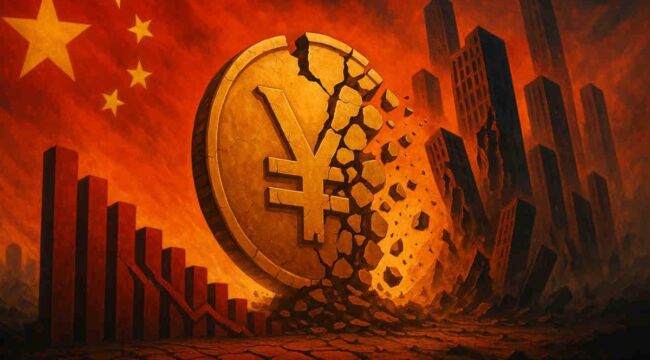The Collapse of Communist China
When I write collapse, I’m not referring just to a financial meltdown. I’m referring to a broad-based social collapse that could call into question the rule of the Chinese Communist Party (CCP), which some historians refer to as the Peasant Dynasty.
In order to understand the vulnerability of China, it helps to consider the counter-narrative that the China is a rising great power. We’ve heard for decades that Chinese GDP would soon exceed U.S. GDP to make China the largest economy in the world. China has also long been known as having the largest population in the world.
The latest addition to the super-China narrative is that China is passing the U.S. in technology and AI and that this technology applied to the People’s Liberation Army (PLA) would give China military superiority as well. From this position, it’s a short hop to a Chinese takeover of Taiwan and expulsion of the U.S. from its position in the Western Pacific. At that point, the Asian Century will have truly displaced the American Century (1914-2008).
Every One of Those Statements Is Wrong
I’ve said for years that Chinese GDP would never surpass U.S. GDP. The reason is that China is now stuck in the middle-income trap. It’s an accomplishment for an economy to move from low per capital annual income (about $5,000) to middle per capital annual income (about $15,000). China has accomplished that. But you cannot simply extrapolate from middle-income to high-income ($24,000 or higher) on a linear basis dependent only on the passage of time.
It takes an extraordinary effort to break out of the middle-income trap. Only a few countries (Japan, Singapore, South Korea and Hong Kong) have ever accomplished it. The key is technology and high-value added production to replace low-value added assembly style production. China has not accomplished this. Most of China’s technology is stolen from the West. That’s not good enough, because the country you stole it from already has it and has already applied it efficiently. You have to invent your own technology and apply it before competitors are even aware. China has failed miserably at this.
Growth Is Near Impossible
Chinese GDP is often touted as a measure of success, but it is overstated by about 100%. Investment is roughly 45% of Chinese GDP compared to about 25% in most developed economies. Over half of Chinese investment is wasted.
I’ve been to China many times and have seen the empty ghost cities and the monumental train stations that are mostly empty. If that wasted investment were written-off, Chinese GDP would drop from 5.0% to 3.6%.
With honest accounting for bad debt in the government-controlled banks, Chinese GDP would drop to 2.0% or lower. China’s government debt-to-GDP ratio of 250% makes it impossible for China to grow faster than the debt burden is growing. This dynamic makes future growth even more difficult.

On the Chinese high-speed train that runs from Shanghai to Beijing at over 300 kph. China has produced major technological advances, but it has done so in non-sustainable ways including excessive debt and theft of intellectual property.
The other impediment to growth in China is demographic. China’s population is shrinking at an alarming rate, partly as a result of the one-child policy (1980-2010). Now, China wants to encourage families to have two or three children. But the damage is done.
Chinese women today do not want families because of new opportunities presented by education, high-paying jobs and urbanization. China will lose over 300 million working age citizens in the next forty years. If output is understood as working age population multiplied by productivity, then economic growth in China is a near impossibility.
And China is no longer the highest population country in the world. They were recently surpassed by India. That population gap between India and China will only widen in the years ahead.
As for military superiority, China is not even close to U.S. capability despite the Biden administration’s cuts in spending on new weapons and combat readiness. China touts its lone aircraft carrier without mentioning that it was actually built by Russia. China is trying to build an aircraft carrier fleet, but that’s an immensely complex task that can take twenty years to fully implement.
China threatens U.S. aircraft carriers with an attack from a Chinese hypersonic missile. That’s possible, but the U.S. response would be to sink the entire Chinese fleet – something similar to what Japan did to Russia in 1905, and the U.S. did to Iran in 1988. An invasion of Taiwan is not in the cards despite continual threats.
Desperate Measures
All of these growth and geopolitical headwinds have been building for years. Now, Trump’s tariff and trade war have hammered the Chinese economy into what is likely to be their first recession since 2008.
Worse yet, the lost orders, factory closures, unpaid wages and lost jobs are causing social unrest that is even more threatening to the Chinese Communist Party (CCP) than slow growth and recession. Here are some snapshots as reported by on-the-scene observers:
- There are numerous reports of factories failing to pay their workers. In some cases, the wage arrears go back six months.
- Arson attacks on railway stations and factories were widespread on February 10th. Many videos of these fires have been posted online.
- Youth unemployment hit 27% at one point in 2024. The government’s response was to cease reporting on youth unemployment. When youth are unemployed or idle, they are more likely to respond with violence in the streets.
- The CCP passed the “Anti-foreign Sanctions Law.” This law retaliates against any US owned company in China that complies with US sanctions against third parties. Russia and Iran are the main targets of such sanctions. The penalty for violating this law is confiscation of all corporate assets in China.
- The CCP government is showing fake stories about riots in U.S. retail stores due to higher prices because of tariffs. One story claims U.S. customers of Walmart and Target are rioting inside stores to buy Chinese goods before tariffs go into effect. Those stories are complete lies but they are propagated to boost morale in China by suggesting China will win the trade war.
- In the recent Thai earthquake only one high-rise building fell. It was a Chinese-built office building that claimed to have advanced anti-earthquake technology according to the CCP.Upon investigation, it was learned that the steel rebar was defective and concrete beams were not built to specifications.After the building collapsed, a group of Chinese nationals breached the police security perimeter to haul away a truck load of business records.Four were arrested. This illustrates how the Chinese do everything. They don’t innovate. They cut corners.
- The official Chinese central news agency aired a story about their plans to invade Taiwan. Those stories employed a string of vulgarities, such as “F*ck Taiwan,” “Taiwan can go f*ck itself,” and “Taiwan sucks,” accompanied by other vulgar quotes from CCP officials. This isn’t diplomacy and it isn’t even good propaganda. It’s a sign of weakness.
- Many Chinese exporters rely on exemption from duties and customs inspections on direct-to-customer shipments from China to end users in the United States where the value is less than $800 per item. Shein and Temu are the principal beneficiaries of this loophole but there are many others. This exemption has destroyed hundreds of thousands of small suppliers in the U.S.The exemption has now been eliminated. Temu’s sales have been crushed and a proposed IPO of Shein in London may be delayed or scaled down as a result.
China’s economy relies on the exploitation of World Trade Organization (WTO) membership, low U.S. tariffs and Wall Street greed that supplies China with capital to go with their slave labor system. All of that is now coming to an end.
Trump’s tariffs will demolish the role of the WTO. The SEC may revoke reporting exemptions currently available to Chinese companies listed in U.S. markets. Wall Street will be regulated in such a way that capital will flow to new investment in the U.S. and not to China. The result will be a body blow to China’s ambitions to grow economically and to finance its military ambitions.
Losing the Mandate of Heaven
If China does not quickly agree to Trump’s agenda, the impact on China will be far worse than lost trade and layoffs. President Xi Jinping will lose what the Chinese call The Mandate of Heaven. This is the source of political legitimacy in China regardless of what formal type of government is in place.
If Xi loses the Mandate of Heaven, China will descend into chaos, unrest and political decentralization as has happened repeatedly over 3,000 years of Chinese civilization. The result will be more profound than even the Cultural Revolution (1966-1976). It will mean the end of the CCP and the current era of Chinese governance.



Comments: